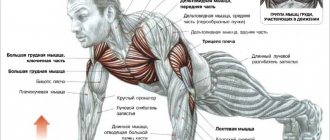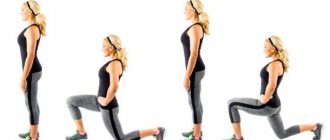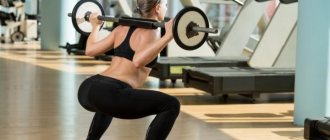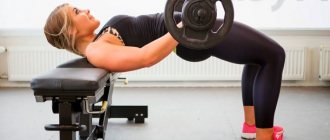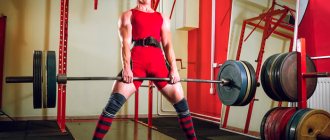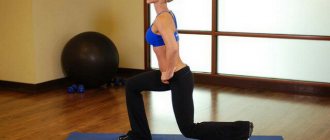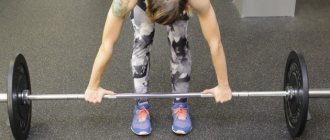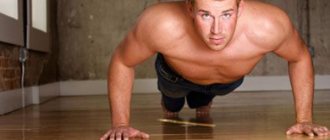In gym programs, bodyweight exercises are becoming increasingly rare. The complexes contain more exercises with free weights and on machines. But push-ups with all sorts of variations have not yet been forgotten. The advantages of this exercise are that variations of push-ups allow you to train muscles from scratch, or diversify the program with a new and effective technique.
Advantages and disadvantages
Benefits of push-ups
- Multi-joint exercise , which allows you to work several muscle groups without additional weights, with your own weight.
- The exercise can be performed anywhere - the gym or at home, and does not require much time and space.
- There are practically no contraindications to performing the exercise and it can be performed at any age. Only with spinal problems is it necessary to control the deflection of the lower back and keep your back straight so as not to aggravate the problem.
- You can do push-ups with any level of physical fitness , from beginner to experienced athlete, depending on the type of exercise chosen.
Flaws
- The exercise is not suitable for gaining muscle mass, since its complexity will not allow you to get the proper load with a small number of repetitions, with the exception of the option of push-ups with weights.
- At first, not everyone can do push-ups with their own weight on the floor; for this it is necessary to prepare the body and strengthen the muscles with preparatory exercises.
Basic types of push-ups. Execution technique
There are many varieties of push-ups, each of which is aimed at working a specific muscle group. Let's look at the most basic options.
Classic push-ups
The most common type of push-up
The classic version of push-ups is taught at school during physical education classes. The technique is quite simple:
- First, a lying position with support on your palms and toes is adopted.
- Legs and back are one straight line.
- The palms are located slightly wider than the shoulders. The fingers are not widely spaced and point forward.
- Feet together or hip-width apart.
- As you inhale, slowly bring your chest toward the floor, bending your elbows. Don't spread them too far apart.
- Exhale and return to the starting position.
Wide grip
This exercise works the pectoral muscles
The technique is similar to the previous one with some exceptions:
- Hands should be placed at a distance equal to approximately two shoulder widths.
- Elbows should be directed to the sides.
- You can gather your palms into a fist or do push-ups with open palms, as in the classic version.
- The legs are shoulder-width apart or slightly narrower.
- When lowering your body, you need to watch your elbows: they should always look to the sides.
- Your back, neck and head should form one straight line.
If you bend or stick out your buttocks, the effectiveness of the exercise will be significantly reduced. A wide grip allows you to maximally pump the pectoral and deltoid muscles.
Wide grip with maximum development of the pectoral muscles
Wide grip with maximum development of the pectoral muscles
This type of push-up is aimed at maximizing the development of the pectoralis major muscle. The technique is the same as in the case of a wide grip, only the legs must be placed on a hill. For beginners, a stand of 30–35 centimeters will be sufficient. Professionals can do push-ups with a stand of 60 centimeters. The higher the stand, the greater the load on the pectoral muscles. You can experiment with the width of your grip. The wider the grip, the greater the load.
Medium grip
This type of push-up is aimed at working the triceps.
The effectiveness of the exercise will depend on the correct placement of the hands.
- Hands should be placed strictly at shoulder level.
- The elbow joints should be directed back.
- Feet together.
- When lowering the body, the elbows move not to the sides, but back along the body.
- The body must be positioned strictly parallel to the floor.
- You can do push-ups on both your palms and your fists.
Narrow grip
Works the triceps and shoulder girdle well
A narrow grip promotes good development of the triceps and anterior deltoid muscles.
- The palms are located next to each other and directed slightly inward.
- Feet are shoulder-width apart or together.
- When lowering the body, the arms bend along the body, and do not diverge to the sides.
One-arm push-ups
This exercise works well on the pectoral and abdominal muscles.
Doing push-ups on one arm is quite difficult; you should switch to this version of the exercise only if classic push-ups do not provide enough load.
- To maintain balance, you need to spread your legs wide apart.
- The supporting arm is located at the shoulder line, and the other arm is slightly bent and placed behind the back.
- When the descent phase occurs, the elbow bends to the side.
- You can do push-ups, alternating your hand after each push-up, or do a few reps on one hand and then change your supporting hand.
Warm-up before push-ups
Any exercise requires a good warm-up to prevent injury. Warm up for 7-10 minutes on a treadmill or orbitrack, you can also do jumping rope. After warming up, perform several rotational movements with your wrists, elbows and shoulders. Stretch your chest muscles, triceps and begin the exercise.
Sets and repetitions of push-ups
If doing push-ups is difficult, do as many push-ups as possible until failure until the muscles stop working. If it has become very easy to do push-ups in all variations, add weights (pancakes, dumbbells) or master complex variations. Perform 3-4 approaches. You shouldn’t do push-ups every day; two workouts a week are enough to give your muscles time to recover.
Exercise technique
The types of push-ups are varied, but there are general rules:
- To work effectively with the pectoral muscles, your elbows need to be moved to the side, so the load on the desired area will be higher. If the elbows are pressed to the sides, the main emphasis will be on the triceps, as is the case with pumping the triceps on the uneven bars.
- No need to be lazy, the distance from the body to the floor should be 10 cm, but you shouldn’t go any lower.
- During the exercise, the body should be in a straight line without arching the back or bulging the buttocks.
- It is important to monitor your breathing. You need to inhale through your nose and exhale through your mouth. Inhale in a relaxed state, and exhale while rising.
- When you manage to bring the number of push-ups to 100, this is not the limit. For intense muscle work, add a load.
- Increase the loads gradually.
To avoid injuring your wrists, use push-up supports.
Classic
The classic execution technique is the basis on which complicated versions of the exercise are built. Before jumping into various modifications, you need to get the basics down first. How to do push-ups correctly for girls and boys:
- Take a lying position.
- To make it easier to keep your body straight, tighten your abs.
- The palms are strictly parallel to each other, located shoulder width apart.
- Elbows are pulled back.
- Look forward or down. Try not to arch your neck; it also forms a single axis with your body and legs.
- Inhaling, lower yourself down onto your elbows.
- When your elbows are bent at a 90% angle, exhale and return to the starting position.
The classic version of the exercise will help strengthen your shoulders, triceps and chest. There are also reverse push-ups from the floor, when the body is positioned with its back to it. The principle of the exercise is the same.
Knee push-ups
If you are still thinking about how to learn how to do push-ups from scratch, choose the simplified option first. It is suitable for beginners and people with spinal problems. Push-ups from the floor on the knees are performed according to the same principle as the classic ones, only instead of the toes, the emphasis moves to the knee joints. the load on the lower back is lower, the effectiveness of push-ups from the knees is 49% compared to 64% in the classic version.
Wide grip push-up
To increase the load on the chest and shoulders, push-ups with a wide grip are good. The arms are positioned twice as wide as in the classic position. How to pump up your pectoral muscles with push-ups and do it right:
- Elbows should be pointing out to the sides, not back.
- Lean on your fist or open palm.
- The feet, unlike the hands, on the contrary, should be pressed tightly against each other.
- Do not stay at the bottom point for a long time, immediately straighten your elbows.
Tighten your abs, watch the position of your hips so that your body remains in one straight line.
From a horizontal surface and from a wall
The first option is difficult for beginners, and it is not suitable for a girl starting from scratch. It is best to start from the wall; despite the apparent ease, the exercise is quite practical. It smoothly prepares joints and muscles for more difficult workloads. How to do it correctly:
- Stand one step away from the wall.
- Straighten your back.
- If you lift your heels off the floor while doing this, this will increase the load on your arms.
- Push up so that when you bend your arms, your chest touches the wall.
It is especially convenient for girls to perform wall push-ups, because there is no risk of overly pumping up their shoulders. This exercise helps tighten your chest and give your arms a more beautiful shape.
With a wide grip to pump up the pectoral muscles
For chest push-ups to be effective, you need to increase the load on your chest. To do this, your legs should be higher than your head, and your palms should be on the floor. Use a low bench, sofa or chair. In the case of training the pectoral muscles on the uneven bars, this exercise pumps up other muscles in this group.
The optimal height of the support is 60 cm, then the pectoral muscles will bear about 75% of your own body weight. Do the exercise with your arms wide apart. After a month of hard training, you will notice how your muscle size increases.
Narrow grip
Triceps push-ups from the floor are constructed differently. Feet shoulder-width apart or slightly wider apart. When doing push-ups from the floor with a narrow position of the arms, when the palms touch each other or are placed crosswise, the main emphasis is on the triceps. The elbows are located along the body and only slightly directed to the side.
Close-grip push-ups are difficult; when performing them, you need to touch your hands at the lowest point. To load your muscles even more, take on additional weight.
Push-up with clap
If you are thinking about how to pump up your arms with push-ups, this exercise is perfect. It develops strength, endurance and hand speed. Body position for clapping push-ups:
- place your feet shoulder-width apart or slightly narrower;
- arms spread wide.
Push your palms off the floor and clap your hands. Do this carefully so that the landing is soft enough. Try to perform the exercise rhythmically, push off the floor with force. This is a good workout for the muscles for those who practice martial arts.
One-arm push-ups
To avoid losing your balance, spread your legs wider, and use supports for comfort and safety. Rules:
- The supporting hand should be exactly in line with the body, the second one should be placed behind the back.
- When lowering, the elbow is directed to the side.
- You need to go as low as possible, touching your chest to the floor.
After completing one set, change hands. This type of exercise is not suitable for beginners; already well-developed muscles will be required. The abs are especially important. This is the most effective method for those who want to increase arm strength.
Medium grip push-up
This exercise will help you work your triceps. You can rest your hands on your palms or clench your hands into fists. Feet shoulder-width apart, arms too, elbows pointing back. Increase the load by placing your feet on an elevated position.
Weighted push-ups
There are some nuances to doing push-ups to gain muscle mass. To increase the load, additional weight is used, due to this the muscles develop better, the deepest areas are worked out. Use different weights:
- vest with weights;
- barbell plate (do not use without insurance);
- backpack with water bottles;
- bag of salt.
A partner is needed to ensure that the weight does not fall from the back during execution if there are no fastenings for it. It is better to start this type of exercise with a small mass. Don't overload yourself, add 1 to 2 kg every week, no more. You can do both narrow push-ups and wide ones.
Deep push-ups
If you are looking for a way to pump up your biceps with push-ups, this exercise option is right for you. The benefits of push-ups can be increased due to the amplitude. To do this, do push-ups with your hands resting on chairs - one under your feet and one under each palm.
Use any stands about 15 cm high or special handles that are designed specifically to increase the amplitude of push-ups. This way you can lower your body below the level of your palms and thereby engage the muscles deeper.
Push-ups
This variation of the exercise helps develop your arms, making them stronger, and strengthens your bones. Choose any grip, the main thing is not to rest on your full palm, but only on your fingers. You should not do this exercise if your fingers and hands are not strong enough. It’s better to work out with an expander first. To increase the difficulty, use a stance.
How to replace push-ups?
If you compare the working muscles during push-ups with other exercises, you can draw a parallel with some exercises with weights, for example, bench press, dumbbells or in a machine. In addition, after the muscles get used to push-ups, you can replace them with presses and progress further. But push-ups cannot be completely replaced, since when performing exercises while lying down, the stabilizer muscles do not work, which additionally work during push-ups, keeping the spine straight.
What muscles work when doing push-ups?
Push-ups affect almost the entire body; this is a universal exercise suitable for any athlete and is not much different in effectiveness from exercises on the uneven bars. It affects different muscle groups if performed correctly. Technique is important, it is the key to safety, and the effectiveness of training depends on it. So, what muscles work when doing push-ups:
- chest;
- triceps;
- gluteal;
- press;
- lower back muscles.
The beauty of push-ups is that you can easily do them at home. They can be supplemented with squats, abdominal exercises, and also push-ups with a reverse grip for variety. This way you can keep yourself in shape, but is it possible to get pumped up by doing push-ups? Yes, but it will require more effort, such as lifting weights.
Warming up before doing push-ups is necessary.

